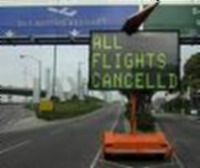Philadelphia's outdated airport builds core of flight delays across United States
Philadelphia's outdated airport takes the first place among others in flight delays across the United States.

It could be decades before passengers see significant improvements at Philadelphia International Airport, routinely one of the nation's most delayed.
Federal Aviation Administration officials, airlines, air traffic controllers and others say Philadelphia plays a major role in delays up and down the coast thanks to poor airport design, bad weather, heavy traffic and proximity to New York.
"If you wanted to show an airport that shows the opposite of what efficient is, Philly would be the poster child," said Don Chapman, local president of the National Air Traffic Controllers union.
Through September, 68 percent of departures were on time in Philadelphia, better only than New York's JFK International, Chicago's O'Hare International and Liberty International in Newark, New Jersey. Fewer than two-thirds of arrivals were on time in Philadelphia during that period.
Nationwide, the airline industry suffered its worst on-time performance in 13 years through September. Over that period, the nation's 20 largest carriers reported that nearly a quarter of all flights arrived late, the most since the industry started keeping track in 1995.
The FAA has deemed Philadelphia a "pacing" airport that, because it sits in the middle of the busy East Coast air corridor, causes delays nationwide. It is debating how to improve the airport, which last year ranked 16th in the nation by passenger volume but is consistently near the bottom of the 32 largest airports in on-time performance.
There is little hope of major relief for this year's holiday travelers. Rain and fog on Monday and Tuesday caused delays leading up to the Thanksgiving rush.
Airport officials are working on extending one runway to accommodate bigger planes. That project, scheduled for completion by the end of next year, is expected to help ease delays somewhat.
The FAA is considering three options for a major airport redesign aimed at realigning runways to allow more planes to take off at once. Construction would take 10 to 15 years and would not start until 2010 at the earliest, at an estimated cost of between $5 billion (3.4 billion EUR) to $6 billion (4 billion EUR).
Meanwhile, the search for more immediate solutions has created an uproar.
Neighbors in the Philadelphia suburbs, and other areas along the East Coast, are angry over an airspace redesign meant to give planes more room. They say the change, which could go into effect next month, will force more flights over their homes and reduce property values.
The FAA also is moving toward alleviating congestion with new navigational technology that would get more planes in the sky at once by allowing them to fly closer together. But air traffic controllers say that would only make the problems worse.
"The cause of delays is not in the air," Chapman said. "The cause of delays is on the ground."
Poor runway arrangement limits the number of planes that can take off from the airport at once, especially during bad weather, Chapman said. Although a small runway was added in 1999, most of the layout dates back to the 1970s or earlier.
But FAA officials call the changes a must for improving the region's clogged system.
"What you have to do is look to use technology and airspace design," FAA spokesman Jim Peters said. "How we improve things in New York and Philadelphia ultimately improves things in the rest of the country."
Meanwhile, baggage handling remains a major struggle three years after a Christmas 2004 disaster. That year, US Airways had to cancel hundreds of flights and thousands of pieces of luggage were stranded in Philadelphia after scores of flight attendants and baggage handlers called in sick.
The airline has since allocated $20 million (13.5 million EUR) toward improving baggage handling facilities, but it is still trying to streamline the operation. Eventually, a new system will be able to process up to 1,200 bags an hour, up from the current 700, said Morgan Durrant, a spokesman for US Airways, the airport's dominant carrier.
In the meantime, Philadelphia's mayor-elect urged travelers to be patient and beseeched them not to allow delays at the city-owned airport to tarnish Philadelphia's image.
"None of these challenges are insurmountable," Michael Nutter said the morning after he was elected Nov. 6. "I'd like to remind many of you that the city of Philadelphia does not handle baggage, nor do we fly airplanes."
Subscribe to Pravda.Ru Telegram channel, Facebook, RSS!


